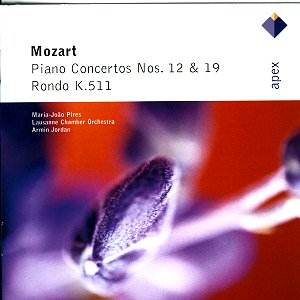Waiting
in the wings for her talents to be fully appreciated at the time
of these recordings, here is Maria João Pires sporting
many characteristics for which she is now renowned: pearly scales,
an infallible innate musicality and a clear affinity with the
music of Mozart. Many of the traits heard here are evidently still
in action, if a recent RFH appearance is anything to go by (S&H
link).
Originally
issued on Erato Disques, the choice of orchestra and conductor
may well be the determining factor here, for there is clearly
a mismatch. Piano Concerto No. 19 comes first in the batting order,
and the scene is set. Jordan and his Lausanne forces are neat
in the initial tutti, but uninspiring in every way. Pedestrian
through and through, one has to wait for Pires’ magical touch
before anything moving can happen. And happen it does. There is
something very confident in Pires’ restraint, and her delicate
entrance bears testimony to this. She consistently outclasses
her colleagues. Listen also to the second movement, where the
orchestra is smooth but perfunctory; Pires immediately creates
intimacy well beyond the orchestra’s reach. Only in the finale
is she a trifle careful-sounding and not wholly involved. The
ending is matter-of-fact, which sums up, certainly, the orchestral
contribution to a tee.
The
same deal is pretty much in operation for the wonderful little
A major Concerto, No. 12 in A, K414. The orchestra chugs its way
along, then Pires starts to play and all of a sudden one listens.
In this first movement, and that of No. 19, the cadenzas are the
high points, a most unusual situation that is due almost certainly
to the fact that the orchestra is silent. Again, in the second
movement, Pires is tender and intimate while the orchestra has
its mind on lunch. The finale is the most successful part of this
performance, appearing to be a determined effort to elevate this
concerto from its designation as the ‘little’ A major.
Then,
at last, we are alone with Pires for the A minor Rondo, K511.
And how much more sense Mozart makes in Pires’ hands alone. It
would be a treat to hear her play this piece today, with perhaps
even more interpretative security, but nevertheless this is a
consistent interpretation that will bring much pleasure. It must
be said that, given the super-budget price tag of this issue,
it is almost worth the purchase for this nine-minute composition.
Colin
Clarke
